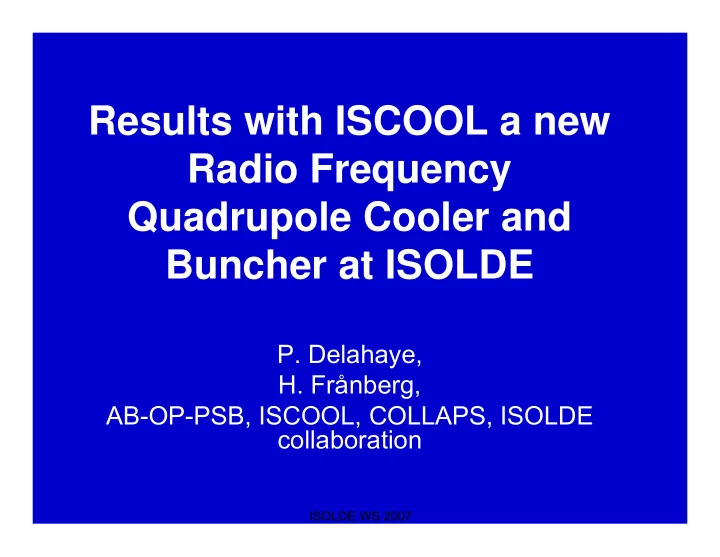

Results with ISCOOL a new Radio Frequency Quadrupole Cooler and Buncher at ISOLDE P. Delahaye, H. Frånberg, AB-OP-PSB, ISCOOL, COLLAPS, ISOLDE collaboration ISOLDE WS 2007
Where at ISOLDE ISCOOL ISOLDE WS 2007
Installation in pictures ISOLDE WS 2007
INSTALLATION � Implementation of the RFQ into the ISOLDE vacuum system. � Construction of HV platform and HV cage of the RFQ. � Standard controls in the working sets: QP arrays for the RFQ and for the beam tuning after the cooler. – RF and gas still on LabVIEW. ISOLDE WS 2007
OPERATION OF ISCOOL • Set-up by the ISOLDE operators. • Improved transmission past the switchyard � Improved (faster and easier) set-up for the beam to the experiments ISOLDE WS 2007
Principle Three elements: RF quadrupolar field � Radial confinement DC potentials � Extracting ion in bunches or in continuous mode Buffer gas � Ion motion cooling V RF ISOLDE WS 2007
Transmissions • Potentials along the axis 5-2V/cm 50V (30V enough) 80eV TRAPPING INJECTION ~1E-2 mbar 4 He EXTRACTION 10 -2 mbar l/s Transmission dependence on the 100 emittance of the ISOLDE ion 80 sources. Transmission 60 ISOLDE on-line surface ion sources has on-line surface ionsource smaller emittance than ISOLDE FEBIAD ion 40 on-line plasma ionsource sources (<25 π ·mm mrad). The off-line tests off-line surface ionsource 20 were performed with an ion source with ε = 35 π mm mrad 0 0 20 40 60 80 100 120 140 Mass ISOLDE WS 2007
Bunching mode 50V (30V enough) 5-2V/cm 80eV 30-60 keV TRAPPING ~1E-2 mbar 4 He INJECTION 10 -2 mbar l/s EXTRACTION ISOLDE WS 2007
Cooling time • TOF < 1ms from the entrance to the exit of the RFQ -3 1.6x10 4 -3 – No losses for short 1.4x10 3 -3 1.2x10 lived ions. Beam gate 2 -3 1.0x10 MCP • 1 passage is enough -4 8.0x10 1 to get a cold beam -4 6.0x10 0 -4 4.0x10 – as measured off-line, -1 -200 0 200 400 600 800 1000 1200 1400 1600 1800 and other labs as Time [ μ s] predicted by simulations for other systems ISOLDE WS 2007
Emittance measurements (off-line) • 10 x decrease of the ~35 π ·mm·mrad 95% emittance beam emittance – The worst case scenario at ISOLDE is the FEBIAD ion source with >25 p·mm·mrad ~2.2 π ·mm·mrad emmittance. 95% emittance • Injection efficiency into the cooler is depending on the beam emittance from the ISOLDE target and ion source unit. ISOLDE WS 2007
Space charge limits 7 1.4x10 7 • Up to 10 8 /s!! As 1.2x10 7 1.0x10 measured with FC Extracted ions 6 8.0x10 6 6.0x10 (data under analysis 6 4.0x10 23 Na with MCP) 6 2.0x10 0.0 8 1.4x10 0.0 7 8 8 8 8 5.0x10 1.0x10 1.5x10 2.0x10 2.5x10 8 Injected ions 1.2x10 1.60E+008 8 1.0x10 85 Rb 1.40E+008 7 Extracted ions 8.0x10 1.20E+008 1.00E+008 7 6.0x10 Extracted ions 39 K, 8.00E+007 7 4.0x10 6.00E+007 Collection time=10 ms–1 sec 4.00E+007 7 Extraction time 150 us 2.0x10 2.00E+007 0.0 0.00E+000 -2.00E+007 0 9 9 9 9 9 1x10 2x10 3x10 4x10 5x10 0.00E+000 4.00E+008 8.00E+008 1.20E+009 Injected ions Injected ions ISOLDE WS 2007
Bunch width Depends on the space charge and cooling time -3 2x10 -3 1x10 0 -3 -1x10 MCP signal -3 -2x10 10 ms -3 -3x10 100 ms 1000 ms -3 -4x10 -3 Collection time=cooling time -5x10 -3 -6x10 -3 -7x10 -3 -8x10 -40 -20 0 20 40 60 80 100 120 140 Time [ μ s] ISOLDE WS 2007
Yield measurements • 26 Na T 1/2 =1.07 s • 48 K T 1/2 =6.8 s • Yields in continuous mode: – 26 Na :1.2e6 at/uC – 48 K: 2.2e4 at/uC • Yields in bunched mode – analysis under progress ISOLDE WS 2007
HOT SPOTS 10 µSv/h 5 µSv/h 5 µSv/h 10 µSv/h 3 µSv/h 15 µSv/h 15 µSv/h 0.5 µSv/h 0.5 µSv/h Beam direction ISOLDE WS 2007
Results • High transmission efficiencies • Easy beam tuning to experiments • Yield measurements continuous vs. bunched mode • Losses due to trapping time (analysis in progress • First measurements with radioactive isotopes performed together with COLLAPS (see next talk) ISOLDE WS 2007
ISOLDE HRS + Cooled beams ISCOOL HRS ISOLDE WS 2007
Outlook Up to October 2007: From Nov. 2007: Next step: Upgrade of HRS Mag 90: EURISOL HIE Isolde: ISOLDE WS 2007
Thanks to: • AB-OP-PSB-iso • SC/RP team: Pascal, • ISOLDE Erwin, Magnus, collaboration Emiliano and Tim. • COLLAPS • AB/ATB collaboration • AB/CO • ISCOOL • AB/PO collaboration • AB/VAC ISOLDE WS 2007
ISOLDE WS 2007
ISCOOL tests with COLLAPS 46 K Beam 1E5 ions/s after the cooler. Collection time 20 minutes, with 300ms bunching and a 12us gate and 2mW of laser power. 502000 200 Bunched:12us gated spectra Singles (continuous counting) 180 500000 160 140 498000 Gated counts Total counts 120 496000 100 80 494000 60 40 492000 20 490000 0 -7 -6 -5 -4 -3 -2 -1 -7 -6 -5 -4 -3 -2 -1 Tuning volts Tuning voltage Background suppression factor~1E4 ISOLDE WS 2007
Recommend
More recommend